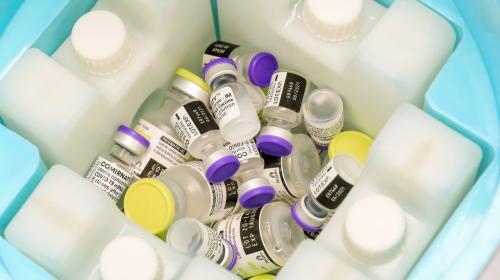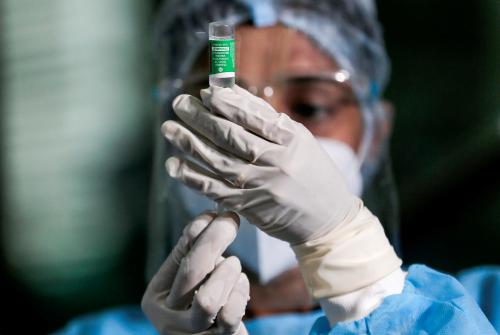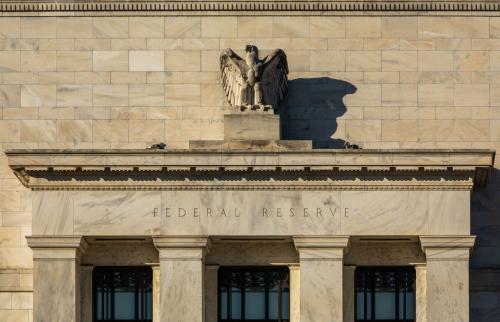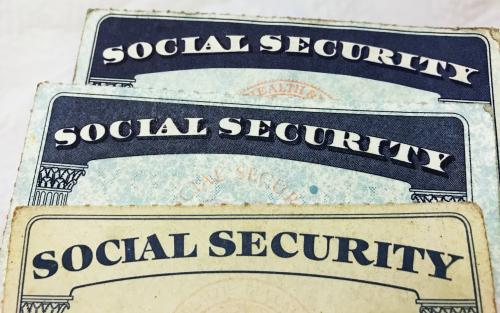On May 5 the Biden administration announced that it would support waiving intellectual property protections for COVID-19 vaccines under the World Trade Organization’s Agreement on Trade-Related Intellectual Property Rights (TRIPS). Predictably, the move drew fiery condemnation from drug companies. In addition, many disinterested observers criticized the support for a TRIPS waiver as empty symbolism, arguing that vaccine patents are not the major obstacle hindering the currently flagging drive to make vaccines available around the world.
Waiving patent protections is certainly no panacea. What is needed most urgently is a massive drive of technology transfer, capacity expansion, and supply line coordination to bring vaccine supply in line with global demand. Dispensing with patents in no way obviates the need for governments to fund and oversee this effort.
Although focusing on these immediate constraints is vital, we cannot confine our attention to the short term. First of all, the COVID-19 pandemic is far from over. Although Americans can now see the light at the end of the tunnel thanks to the rapid rollout of vaccines, most of the world isn’t so lucky. The virus is currently raging in India and throughout South America, overwhelming health care systems and inflicting suffering and loss on a horrific scale. And consider the fact that Australia, which has been successful in suppressing the virus, recently announced it was sticking to plans to keep its borders closed until mid-2022. Criticisms of the TRIPS waiver that focus only on the next few months are therefore short-sighted: this pandemic could well drag on long enough for elimination of patent restrictions to enable new vaccine producers to make a positive difference.
Furthermore, and probably even more important, this is almost certainly not the last pandemic we will face. Urbanization, the spread of factory-farming methods, and globalization all combine to increase the odds that a new virus will make the jump from animals to humans and then spread rapidly around the world. Prior to the current pandemic, the 21st century already saw outbreaks of SARS, H1N1, MERS, and Ebola. Everything we do and learn in the current crisis should be viewed from the perspective of getting ready for next time.
The Nature of the Patent Bargain
When we take the longer view, we can see a fundamental mismatch between the policy design of intellectual property protection and the policy requirements of effective pandemic response. Although patent law, properly restrained, constitutes one important element of a well-designed national innovation system, the way it goes about encouraging technological progress is singularly ill-suited to the emergency conditions of a pandemic or other public health crisis. Securing a TRIPS waiver for COVID-19 vaccines and treatments would thus establish a salutary precedent that, in emergencies of this kind, governments should employ other, more direct means to incentivize the development of new drugs.
Here is the basic bargain offered by patent law: encourage the creation of useful new ideas for the long run by slowing the diffusion of useful new ideas in the short run. The second half of the bargain, the half that imposes costs on society, comes from the temporary exclusive rights, or monopoly privileges, that a patent holder enjoys. Under U.S. patent law, for a period of 20 years nobody else can manufacture or sell the patented product without the permission of the patent holder. This allows the patent holder to block competitors from the market, or extract licensing fees before allowing them to enter, and consequently charge above-market prices to its customers. Patent rights thus slow the diffusion of a new invention by restricting output and raising prices.
The imposition of these short-run costs, however, can bring net long-term benefits by sharpening the incentives to invent new products. In the absence of patent protection, the prospect of easy imitation by later market entrants can deter would-be innovators from incurring the up-front fixed costs of research and development. But with a guaranteed period of market exclusivity, inventors can proceed with greater confidence that they will be able to recoup their investment.
For the tradeoff between costs and benefits to come out positive on net, patent law must strike the right balance. Exclusive rights should be valuable enough to encourage greater innovation, but not so easily granted or extensive in scope or term that this encouragement is outweighed by output restrictions on the patented product and discouragement of downstream innovations dependent on access to the patented technology.
Unfortunately, the U.S. patent system at present is out of balance. Over the past few decades, the expansion of patentability to include software and business methods as well as a general relaxation of patenting requirements have led to wildly excessive growth in these temporary monopolies: the number of patents granted annually has skyrocketed roughly fivefold since the early 1980s. One unfortunate result has been the rise of “non-practicing entities,” better known as patent trolls: firms that make nothing themselves but buy up patent portfolios and monetize them through aggressive litigation. As a result, a law that is supposed to encourage innovation has turned into a legal minefield for many would-be innovators. In the pharmaceutical industry, firms have abused the law by piling up patents for trivial, therapeutically irrelevant “innovations” that allow them to extend their monopolies and keep raising prices long beyond the statutorily contemplated 20 years.
Patent law is creating these unintended consequences because policymakers have been caught in an ideological fog that conflates “intellectual property” with actual property rights over physical objects. Enveloped in that fog, they regard any attempts to put limits on patent monopolies as attacks on private property and view ongoing expansions of patent privileges as necessary to keep innovation from grinding to a halt. In fact, patent law is a tool of regulatory policy with the usual tradeoffs between costs and benefits; like all tools, it can be misused, and as with all tools there are some jobs for which other tools are better suited. A well-designed patent system, in which benefits are maximized and costs kept to a minimum, is just one of various policy options that governments can employ to stimulate technological advance—including tax credits for R&D, prizes for targeted inventions, and direct government support.
Public Health Emergencies and Direct Government Support
For pandemics and other public health emergencies, patents’ mix of costs and benefits is misaligned with what is needed for an effective policy response. The basic patent bargain, even when well struck, is to pay for more innovation down the road with slower diffusion of innovation today. In the context of a pandemic, that bargain is a bad one and should be rejected entirely. Here the imperative is to accelerate the diffusion of vaccines and other treatments, not slow it down. Giving drug companies the power to hold things up by blocking competitors and raising prices pushes in the completely wrong direction.
What approach to encouraging innovation should we take instead? How do we incentivize drug makers to undertake the hefty R&D costs to develop new vaccines without giving them exclusive rights over their production and sale? The most effective approach during a public health crisis is direct government support: public funding of R&D, advance purchase commitments by the government to buy large numbers of doses at set prices, and other, related payouts. And when we pay drug makers, we should not hesitate to pay generously, even extravagantly: we want to offer drug companies big profits so that they prioritize this work above everything else, and so that they are ready and eager to come to the rescue again the next time there’s a crisis.
It was direct support via Operation Warp Speed that made possible the astonishingly rapid development of COVID-19 vaccines and then facilitated a relatively rapid rollout of vaccine distribution (relative, that is, to most of the rest of the world). And it’s worth noting that a major reason for the faster rollout here and in the United Kingdom compared to the European Union was the latter’s misguided penny-pinching. The EU bargained hard with firms to keep vaccine prices low, and as a result their citizens ended up in the back of the queue as various supply line kinks were being ironed out. This is particularly ironic since the Pfizer-BioNTech vaccine was developed in Germany. As this fact underscores, the chief advantage of direct support isn’t to “get tough” with drug firms and keep a lid on their profits. Instead, it is to accelerate the end of the public health emergency by making sure drug makers profit handsomely from doing the right thing.
Patent law and direct support should be seen not as either-or alternatives but as complements that apply different incentives to different circumstances and time horizons. Patent law provides a decentralized system for encouraging innovation. The government doesn’t presume to tell the industry which new drugs are needed; it simply incentivizes the development of whatever new drugs that pharmaceutical firms can come up with by offering them a temporary monopoly. It is important to note that patent law’s incentives offer no commercial guarantees. Yes, you can block other competitors for a number of years, but that still doesn’t ensure enough consumer demand for the new product to make it profitable.
Direct Support Makes Patents Redundant
The situation is different in a pandemic. Here the government knows exactly what it wants to incentivize: the creation of vaccines to prevent the spread of a specific virus and other drugs to treat that virus. Under these circumstances, the decentralized approach isn’t good enough. There is no time to sit back and let drug makers take the initiative on their own timeline. Instead, the government needs to be more involved to incentivize specific innovations now. As recompense for letting it call the shots (pardon the pun), the government sweetens the deal for drug companies by insulating them from commercial risk. If pharmaceutical firms develop effective vaccines and therapies, the government will buy large, predetermined quantities at prices set high enough to guarantee a healthy return.
For the pharmaceutical industry, it is useful to conceive of patent law as the default regime for innovation promotion. It improves pharmaceutical companies’ incentives to develop new drugs while leaving them free to decide which new drugs to pursue – and also leaving them to bear all commercial risk. In a pandemic or other emergency, however, it is appropriate to shift to the direct support regime, in which the government focuses efforts on one disease. In this regime, it is important to note, the government provides qualitatively superior incentives to those offered under patent law. Not only does it offer public funding to cover the up-front costs of drug development, but it also provides advance purchase commitments that guarantee a healthy return.
It should therefore be clear that the pharmaceutical industry has no legitimate basis for objecting to a TRIPS waiver. Since, because of the public health crisis, drug makers now qualify for the superior benefits of direct government support, they no longer need the default benefits of patent support. Arguments that a TRIPS waiver would deprive drug makers of the incentives they need to keep developing new drugs, when they are presently receiving the most favorable incentives available, can be dismissed as the worst sort of special pleading.
That said, it is a serious mistake to try to cast the current crisis as a morality play in which drug makers wear the black hats and the choice at hand is between private profits and public health. We would have no chance of beating this virus without the formidable organizational capabilities of the pharmaceutical industry, and providing the appropriate incentives is essential to ensure that the industry plays its necessary and vital role. It is misguided to lament that private companies are profiting in the current crisis: those profits are a drop in the bucket compared to the staggering cost of this pandemic in lives and economic damage.
What matters isn’t the existence or size of the profits, but how they are earned. We have good reason to want drug makers to profit from vaccinating the world: the comparative price is minuscule, and the incentive effects are a vital safeguard of public health in the event of future crises. What we want to avoid at all costs is putting drug makers in the position where drug companies can profit from standing in the way of rapid global vaccination. That is why intellectual property rights need to be taken out of the equation.
Vaccinating the world in any kind of reasonable time frame will require large-scale technology transfer to drug firms in other countries and rapid expansion of their production capacity. And looking beyond the current pandemic to the longer term, we need ample, redundant global vaccine production capacity that is widely distributed around the planet. To achieve these goals as rapidly as possible will require the active cooperation of the U.S. pharmaceutical industry, which is why the direct support model now needs to be extended. What is needed now is an Operation Warp Speed for the world, in which we make it worth current vaccine producers’ while to share their know-how broadly and ramp up global capacity.
Here again, we must recognize that the choice isn’t between people on the one hand and profits on the other. Rather, the key to good pandemic response policy is ensuring that incentives are structured so that drug company profit-seeking and global public health are well aligned. That means opting out of the default, decentralized patent bargain in favor of generous but well-focused direct government support.
The author did not receive financial support from any firm or person for this article or from any firm or person with a financial or political interest in this article. They are currently not an officer, director, or board member of any organization with an interest in this article.
The Brookings Institution is committed to quality, independence, and impact.
We are supported by a diverse array of funders. In line with our values and policies, each Brookings publication represents the sole views of its author(s).







Commentary
Why intellectual property and pandemics don’t mix
June 3, 2021